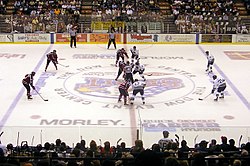
An important defensive tactic is checking – attempting to take the puck from an opponent or to remove the opponent from play. Forechecking is checking in the other team's zone; backchecking is checking while the other team is advancing down the ice toward one's own goal. These terms usually are applied to checking by forwards. Stick checking, sweep checking, and poke checking are legal uses of the stick to obtain possession of the puck. Body checking is using one's shoulder or hip to strike an opponent who has the puck or who is the last to have touched it (within a short period of time after possession; usually less than three seconds). Often the term checking is used to refer to body checking, with its true definition generally only propagated among fans of the game.
Offensive tactics include improving a team's position on the ice by advancing the puck out of one's zone towards the opponent's zone, progressively by gaining lines, first your own blue line, then the red line and finally the opponent's blue line. NHL rules instated for the 2006 season redefined icing to make the two-line pass legal; a player may pass the puck from behind his own blue line, past both that blue line and the centre red line, to a player in front of the opponents' blue line. In fact, an errant pass that would normally result in an icing call is negated if the player for whom the pass was intended gains possession of the puck before it crosses the opponents' goal line; thus a "three-line pass" can be attempted with a fast forward as long as an offsides is not committed. Offensive tactics are designed ultimately to score a goal by taking a shot. When a player purposely directs the puck towards the opponent's goal, he or she is said to shoot the puck.

A deflection is a shot which redirects a shot or a pass towards the goal from another player, by allowing the puck to strike the stick and carom towards the goal. A one-timer is a shot which is struck directly off a pass, without receiving the pass and shooting in two separate actions. A deke (short for decoy) is a feint with the body and/or stick to fool a defender or the goalie. Headmanning the puck, also known as cherry-picking or breaking out, is the tactic of rapidly passing to the player farthest down the ice.
A team that is losing by one or two goals in the last few minutes of play will often elect to pull the goalie; that is, removing the goaltender and replacing him or her with an extra attacker on the ice in the hope of gaining enough advantage to score a goal. However, it is an act of desperation, as it sometimes leads to the opposing team extending their lead by scoring a goal in the empty net.
A delayed penalty is a penalty offense committed by the team that does not have possession of the puck. In this circumstance the team with possession of the puck is allowed to complete the play; that is, play continues until a goal is scored, the puck is shot, stopped and controlled by the opposing goalie, a player on the opposing team gains control of the puck, or the team in possession commits an infraction or penalty of their own. Because the team on which the penalty was called cannot control the puck without stopping play, it is impossible for them to score a goal; in these cases the team in possession of the puck can pull the goalie for an extra attacker without fear of being scored on. This situation ends as soon as the team in possession completes the play and the penalty is assessed (if a delayed penalty is signalled and the team in possession scores, the penalty is still assessed to the offending player).
Although it is officially prohibited in the rules, at the professional level in North America fights are sometimes used to affect morale of the teams, with aggressors hoping to demoralize the opposing players while exciting their own, as well as settling personal scores. Both players in an altercation receive five-minute major penalties for fighting. The player deemed to be the "instigator" of an NHL fight, if one is determined to exist, is penalized an additional two minutes for instigating, plus a ten-minute misconduct penalty. If there is no instigator, both players stay in the penalty box for five minutes, and neither team loses skaters. They point to less extreme on-ice violence during the era before the rule was introduced. Toronto Maple Leafs owner Conn Smythe famously observed that "If you can't beat 'em in the alley you can't beat 'em on the ice."[21]

The Neutral zone trap:
The trap is designed to isolate the puck carrier in the neutral zone preventing him from entering the offensive zone. In youth hockey development of the neutral zone trap often begins with the left wing lock. In this tactic the left wing plays in the normal position of the left defence men while in the offensive zone. The left defenceman then moves to the centre. The centre and right wing chase the puck. When the opposing team gains control of the puck, the defencemen and the left wing pull out and set a two man trap along the boards. The left or right wing available, backs up the trap while the centre and right wing pursuit and try to get in front of the play further blocking the offensive attack.



No comments:
Post a Comment